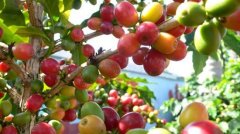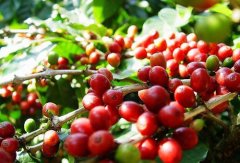A comprehensive understanding of the types of Starbucks coffee
In 1971, three famous baristas, Jerry, Gordon and Giff, founded Starbucks Starbucks in Seattle, USA. They only sold heavy-baked coffee brewed by using pressure pots, not drinks and desserts, and soon became popular all over the United States. The emergence of Starbucks changed the situation of instant coffee unifying the United States, which had a far-reaching impact at that time.
In 1974, Starbucks marketing manager Howard Schultz bought Starbucks Starbucks and introduced lattes and cappuccinos made from espresso and soft foam. Italian-born espresso has been pushed onto the world coffee stage in the United States on the other side of the ocean. Starbucks is growing rapidly all over the world.
After the 2008 financial tsunami, Starbucks Starbucks launched the low-cost VIA instant coffee in order to seize the shrinking market. The stock price rose and the store was alive, but fans was somewhat disappointed.
Some people are proud that they drink a cup of Starbucks coffee every day and think they know a lot about coffee, which is very trendy and fashionable. Just talk about lattes, cappuccinos, mochas, or caramel macchiato. In fact, people who know coffee will inevitably despise it when they listen to it. Whether it is a latte or a cappuccino, it is a "coffee drink" mixed with milk and coffee.
Starbucks Starbucks can only drink espresso (espresso) and its fancy coffee with milk. As the saying goes: Italians are very "impetuous". They dislike that the general method of making coffee is very slow and inefficient, so they invented an Italian coffee machine that can be extracted quickly in 20-30 seconds. Hot water passes quickly through coffee powder under certain pressure. A strong cup of coffee is made. Espresso is strong, bitter and thick before adding milk. With enough milk (milk foam), such as lattes, the curry is still fragrant. This is the beauty of coffee conversion. Starbucks used it perfectly. The popular categories of coffee on the market: latte, cappuccino, mocha, Ole, etc., are actually espresso and its derivatives, which is the result of Starbucks guidance and the result it hopes for, but he is actually wrong. This is just the classification of espresso, not coffee.
Espresso (Starbucks) is not equal to coffee, it is just a kind of coffee, more accurately, it is a way of making coffee.
In terms of individual coffee: different continents, different elevations and different climates produce different coffee beans, they have their own beautiful names and taste, elegant and noble Blue Mountain coffee from Jamaica, sweet and mellow Mantenin from Indonesia, fine balanced cream rich Syrador Brazil, sweet and lively Kona from Hawaii.
In terms of production methods: they can also be made with siphon pots, French presses, hand flushing pots, Belgian pots, Vietnamese pots, American trickling pots and Italian coffee machines, showing different tastes and features.
The siphon pot is as accurate as an instrument, coffee beans and water are fully mixed in the cooking process, and it can perfectly filter the coffee grounds to make the coffee extract more fully. This is the most commonly used instrument for making black coffee in cafes, and it tastes good when mastered properly.
The Belgian pot belongs to the same family as the siphon pot, which uses steam to compress the gas and let it run back and forth to mix the coffee to form a beautiful taste, but the Belgian pot is very royal and has more ornamental value.
Hand brewing pot is a common method of fine coffee, the temperature of about 90 degrees, it is not easy to destroy the original flavor of coffee, the level is more rich, is the favorite of coffee enthusiasts. However, the hand-made pot seems simple, but in fact, the requirements of baristas are very high, not only to have skilled techniques, but also to understand the different baking characteristics of different beans, which is not elementary and manageable.
French pots and Vietnamese pots are good partners for beginners, easy to get, and taste good, but there is a gap with professional siphon pots and hand flushing pots. Mocha pots and espresso machines are both tools for making espresso, and they both need to increase atmospheric pressure to increase consistency.
In this respect, the espresso machine performs better. On the other hand, all kinds of American drip filter pots for household use are the "stupid version" of hand-brewed coffee, and the household automatic coffee machine is the "simplified version" of Italian coffee machine.

Important Notice :
前街咖啡 FrontStreet Coffee has moved to new addredd:
FrontStreet Coffee Address: 315,Donghua East Road,GuangZhou
Tel:020 38364473
- Prev

There are nine conditions for opening a coffee shop.
1. The personality of an independent boss is the personality of a personality-themed cafe, which is the first competitiveness of this kind of cafe. As most of the small and medium-sized cafes are single shops, these shops will have the distinct personality characteristics of the boss. By releasing these character symbols in the store, it will attract a group of customers with the same personality traits, and then continue to attract
- Next

Why is coffee bitter? How to make coffee less bitter?
Caffeine is the most well-known bitter ingredient in coffee, but caffeine actually accounts for only 10% of the bitter taste. This can be understood from the fact that the concentration of caffeine in roasted beans is not affected by the degree of baking, and that decaffeinated coffee also has a bitter taste. So where does the remaining 90% of the bitterness come from? One of the sources of coffee bitterness is brown pigment. Brown color
Related
- Beginners will see the "Coffee pull flower" guide!
- What is the difference between ice blog purified milk and ordinary milk coffee?
- Why is the Philippines the largest producer of crops in Liberia?
- For coffee extraction, should the fine powder be retained?
- How does extracted espresso fill pressed powder? How much strength does it take to press the powder?
- How to make jasmine cold extract coffee? Is the jasmine + latte good?
- Will this little toy really make the coffee taste better? How does Lily Drip affect coffee extraction?
- Will the action of slapping the filter cup also affect coffee extraction?
- What's the difference between powder-to-water ratio and powder-to-liquid ratio?
- What is the Ethiopian local species? What does it have to do with Heirloom native species?

